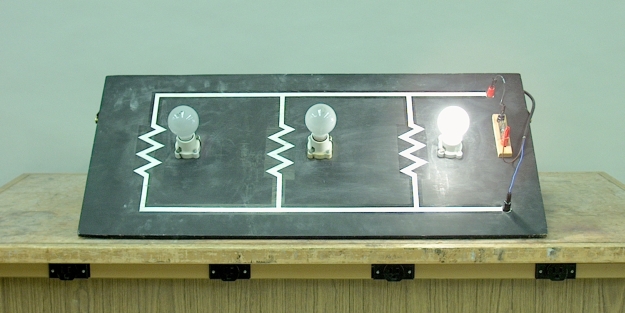
A video of this demonstration is available at this link.
Three 40-watt bulbs are connected in parallel with only one of the bulbs fully screwed into its socket. A 0.5-ampere fuse is inserted between one side of the AC line (in the photograph above it is the hot side) and the parallel bulb circuit. When you turn the power on, only one bulb lights. Screw in the middle bulb, then the last bulb. The fuse burns out when the last bulb is screwed in.
Each 40-watt light bulb draws (40 watts/120 volts) = 0.33 amperes. Two in parallel, then, draw 0.66 A. Fuses are designed to carry their rated current indefinitely. They can carry somewhat greater currents for a while, but will eventually fail if the current through them continues to exceed their rated value. The greater the amount by which the current exceeds the rating, the shorter the time until the fuse fails. At the 0.66-A current load of two 40-watt bulbs, the fuse can survive for some time. The roughly 1-A draw of all three bulbs together, however, is enough to cause the fuse to fail immediately.
The way the fuse works is that current flowing through the fuse element, a thin wire, heats it up. The fuse can dissipate a certain amount of heat, so that below its rated current, the fuse carries the current without distorting or melting. Above its rated current, the fuse cannot dissipate enough heat to keep from either distorting and eventually failing, or, in cases of severe overload, melting (or even vaporizing). Of course, when the fuse element melts or otherwise breaks, the circuit is open, and current cannot flow. This protects components in the circuit that could be damaged by excessive current, or, when something in the circuit has failed in such a way as to cause excessive current draw, it prevents overheating of that component and the possible fire that could lead to.
There are many types of fuses, but those most commonly used in appliances and consumer electronics are generally of two broad classes: fast-acting and time-delay (also commonly known by the trademark “Slo-Blo®”). The fuse in the above circuit is a fast-acting 0.5-A fuse. While the resistance of a lightbulb does change when you turn it on, the initial current draw is not excessive. For some circuits, however, during a short time after power is applied or removed, the current draw can change dramatically. In DC power supplies, for example, the filter capacitors draw significant current when they first charge. (See, for example, demonstration 64.51 -- RC circuit to galvanometer, or 64.54 -- RC circuit to oscilloscope.) Conversely, in circuits with large inductors, such as transformers, there can be a large surge in current when power is disconnected. (See, for example, demonstration 72.54 -- Inductor spark.) In such cases, one uses a time-delay fuse. This type of fuse can handle this initial or final current surge without failing, but a sustained current of a similar magnitude causes it to fail after a short time.